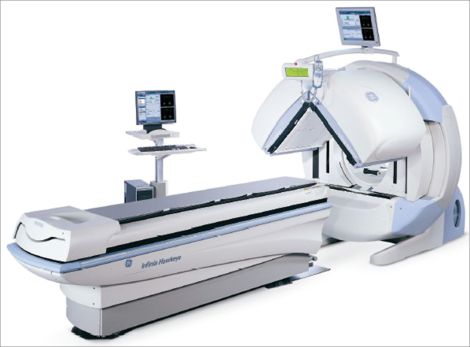- Evaluate the differential kidney function
- Assess for ureteral obstruction
- Evaluate kidney function post-procedure
Preparation
For a renal scan, you are required to be well hydrated prior to the test. This means that you should drink a couple of glasses of water slowly within 1-2 hours prior to the test.
You are also required to refrain from having caffeine (coffee, tea, pop, chocolate, etc.) for 8 hours prior to the test.
You do not need a full bladder and may empty out your bladder as required.
PLEASE INFORM YOUR DOCTOR OR THE TECHNOLOGIST IF YOU ARE,
OR THINK YOU MIGHT BE PREGNANT OR BREASTFEEDING.
Procedure
Check-in at the Diagnostic Imaging Department at the Sault Area Hospital for your appointment.
To perform a renal scan you will be positioned on your back underneath the camera; your head will not go underneath the camera. You will be administered a small injection of a radioactive tracer (Technetium-99m Pentetate) into a vein and we will begin taking pictures immediately. Images will be taken over the course of 30 minutes displaying how the radioactive injection is cleared out of your blood through your kidneys. After 30 minutes, it may be necessary to perform a second test if there is retention of the tracer in the kidneys.
The second test to examine retention of the radioactive tracer in the kidneys is carried out in a similar manner to the initial renal scan. You will be positioned under the camera in the same position as before. You will then be given an injection of the diuretic Lasix (Furosemide). The diuretic will make your kidneys work harder and it should clear out most of the radiotracer that may still be in the kidneys. Images will be acquired following the injection and last for at least 20 minutes.
Following your test, there are no restrictions and you will be able to drive as you normally would. If you are planning on going into the United States of America you will set off the radiation detectors for approximately 2-3 days. We can provide a letter explaining why you are setting off the detectors however you will still be stopped.
Once your scan is complete it will be examined by a radiologist and a report will be sent to the ordering doctor within a week. Follow up your test with the ordering physician or your family doctor.
The Injection
The amount of radioactive tracer injected for a renal scan is small enough that there are no additional requirements or precautions to protect others from radiation exposure. The radiation exposure to you is less than a standard chest x-ray. Most of the injection will be cleared out of your body through your urine within 24 hours.
Allergic reactions to the materials used are extremely rare. You shouldn’t feel anything from the radioactive material, however, if you receive the diuretic injection you may feel the urge to urinate.
The Camera
For a renal scan, we acquire the images using a gamma camera. A gamma camera is a type of radiation detector that is used to show us how the radioactive tracer passes through your kidneys and into your bladder. Our cameras do not emit radiation or loud noises and are not a hazard to anyone in the vicinity while acquiring. The cameras we use have 2 detectors: one above you and one below you. For a renal scan, we will only be using the detector below you, the detector above you will remain as high up as it can be.

